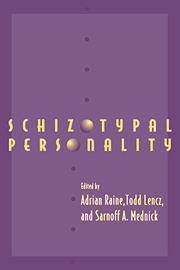Book contents
- Frontmatter
- Contents
- List of contributors
- Preface
- Acknowledgments
- Part I Introduction
- Part II Genetics and neurodevelopment
- Part III Assessment
- Part IV Categorical versus dimensional approaches
- Part V Psychophysiology and psychopharmacology
- Part VI Neuropsychology
- 13 Neuropsychological abnormalities associated with schizotypal personality
- 14 Syndromes of schizotypy: patterns of cognitive asymmetry, arousal, and gender
- 15 Working memory deficits, antisaccades, and thought disorder in relation to perceptual aberration
- Part VII Brain imaging
- Part VIII Conclusion
- Part IX Appendix
- Name Index
- Subject Index
15 - Working memory deficits, antisaccades, and thought disorder in relation to perceptual aberration
from Part VI - Neuropsychology
Published online by Cambridge University Press: 04 August 2010
- Frontmatter
- Contents
- List of contributors
- Preface
- Acknowledgments
- Part I Introduction
- Part II Genetics and neurodevelopment
- Part III Assessment
- Part IV Categorical versus dimensional approaches
- Part V Psychophysiology and psychopharmacology
- Part VI Neuropsychology
- 13 Neuropsychological abnormalities associated with schizotypal personality
- 14 Syndromes of schizotypy: patterns of cognitive asymmetry, arousal, and gender
- 15 Working memory deficits, antisaccades, and thought disorder in relation to perceptual aberration
- Part VII Brain imaging
- Part VIII Conclusion
- Part IX Appendix
- Name Index
- Subject Index
Summary
The larger than usual number of authors of this paper (listed, except for the first author, alphabetically) indicates that this research was a team effort in which three studies were conducted simultaneously by three teams of investigators. The effort began when Mark Lenzenweger conceived of the idea to study normally functioning college students who, on psychometric examination, showed significant elevations on traits that Loren and Jean Chapman have identified as schizotypal. Lenzenweger thought that it would be informative to determine how these students performed on tests that distinguish schizophrenic patients and their relatives from both the normal population and patients with nonschizophrenic illnesses. The scientists in our laboratory agreed.
Three teams of investigators set out from the Harvard-McLean Hospital laboratory to work at Cornell University, where they completed the testing of 57 people in Lenzenweger's population. Each of the teams completed a report of its own, which has been submitted for publication; these reports are summarized here. In addition, this chapter considers the performance of these college students on all of the tasks, which could not be done in the individual reports. The three tasks are (1) delayed response, from which we assess working memory; (2) antisaccade eye movements, and (3) thought disorder assessed from the Thought Disorder Index (TDI).
Rationale
The measures
For many years, the Psychology Research Laboratory at McLean Hospital has been studying psychological and psychophysiological characteristics that are associated with schizophrenia. Some of these performance measures show a familial aggregation among the relatives of schizophrenic individuals, which enhanced their significance beyond the mere demonstration that performance was deviant in a group of psychotic people.
Keywords
- Type
- Chapter
- Information
- Schizotypal Personality , pp. 353 - 382Publisher: Cambridge University PressPrint publication year: 1995
- 9
- Cited by



